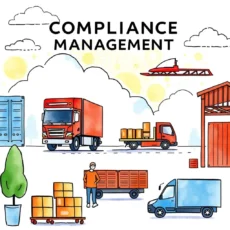Risk alert monitor: Create alerts for potential supply chain risks
Use risk alert monitor to identify, assess, and manage potential risks across operations efficiently. Streamline your risk reporting and monitoring today!

Maximize your risk management with comprehensive supply chain alerts
Streamline supply chain risk alerts for better operations

Easy text input for risk description
Easily enter the risk description using a straightforward text input field. This feature ensures that all relevant details are captured, allowing for improved analysis and enhanced communication among team members regarding identified supply chain risks.

Customizable risk category selection
Select from various categories such as Operational, Financial, or Compliance to classify each risk accurately. This tailored approach helps streamline risk management efforts, ensuring that alerts and reporting are relevant to specific issues impacting your supply chain operations.

Date of identification tracking
Record the date of risk identification conveniently within the app. Keeping a timeline helps prioritize risks effectively and ensures that the team stays focused on the most critical issues affecting operational efficiency.

Potential impact assessment
Input potential impact levels—High, Medium, or Low—associated with each identified risk. This feature aids in better understanding the severity of risks and supports decision-making processes regarding resource allocation and mitigation strategies.

Likelihood of occurrence evaluation
Easily assess and indicate how likely a particular risk is to occur using High, Medium, or Low options. Understanding likelihood helps teams focus their monitoring efforts on risks with higher probabilities, enhancing overall risk response strategies.

Detailed mitigation strategies input
Provide specific mitigation strategies directly related to each risk. This ensures that actionable steps are documented alongside risks, facilitating accountability and leading to more structured follow-up actions within the supply chain management process.

Responsible team member/department assignment
Designate a responsible team member or department for each identified risk. This feature enhances ownership and accountability, ensuring clear lines of communication when addressing potential supply chain disruptions.

Status monitoring updates
Track the status of each risk by categorizing them as Open, Closed, or Monitoring. This provides clarity on current risk management efforts while fostering a proactive approach toward resolving outstanding issues in your operations.

Last review date logging
Document the date of the last review for ongoing evaluation of identified risks. Regularly updating this information enables effective continuous improvement cycles in your risk management process and promotes timely responses to changing conditions in logistics operations.

Additional comments field for insights
Include any extra comments or notes relevant to specific risks through an additional comments field. This flexibility allows users to articulate unique contexts surrounding risks that standard fields may not cover, boosting overall understanding within your team.
Additional information
Best for: Risk Management Analyst, Logistics Risk Coordinator, Supply Chain Risk Manager, Operations Risk Monitoring Specialist, Risk Reporting Analyst